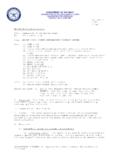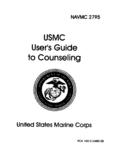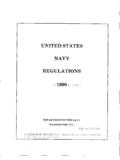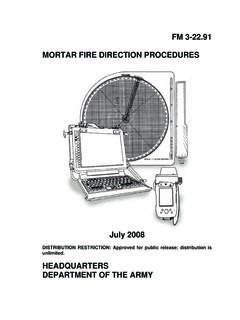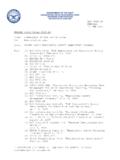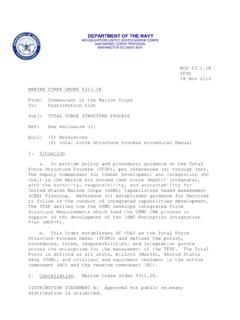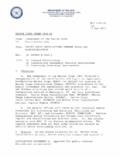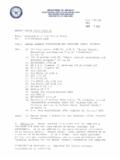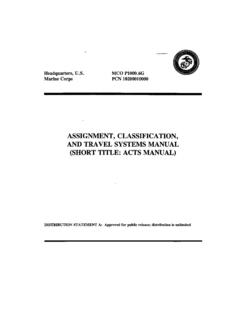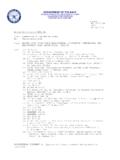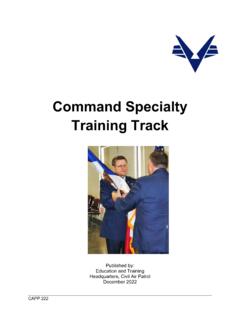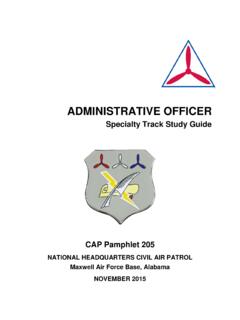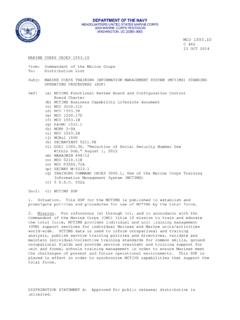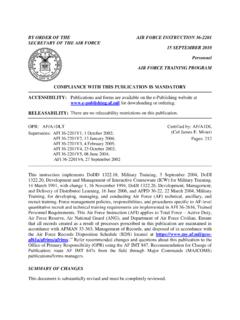Transcription of MCRP 6-11D Sustaining the Transformation
1 MCRP 6-liDSustaining the Marine CorpsPCN 144 000075 00 DISTRIBUTION STATEMENT A: Approved for public release; distribution is OF THE NAVYH eadquarters United States Marine CorpsWashington, 20380-177528 June 1999 FOREWORDOur Corps does two things for America: we make Marinesand we win our nation's battles. Our ability to successfullyaccomplish the latter, of course, depends upon how well wedo the former. We make Marines through a process calledtransformation. During this process, we change youngmen's and women's lives forever by imbuing them with ournation's highest the birth of our Corps,Marines have been forged in the crucible of our entry-leveltraining, whether it be recruit training or Officer CandidatesSchool. Through the years we have refined and strength-ened this process in pursuit of increasingly higher who earn the title "Marine" have been polished andhoned by attentive mentoring and the application of ourtime-proven leadership traits and principles.
2 Transformationdoes not end at the conclusion of entry-level training ; it con-tinues throughout a Marine's service whether that serviceends after a single enlistment or lasts 30 years. Marinesmaintain standards that are consistent with our core valuesof honor, courage, and commitment, and they are heldaccountable for maintaining the legacy of valor establishedby the sacrifices of those Marines who preceded them. AsMarines leave our active ranks, they carry our timelessvalues with them back to their civilian communities, andour nation is stronger for it. This Transformation , as timelessas the Corps itself, is our legacy to Corps' survival depends upon the Marines enter our Corps today with as much spiritand enthusiasm as ever in our proud history. They carrywithin their hearts the burning embers of zeal and devotionthat were lit during their first meeting with a Marine (active,reserve, retired, or former) or during their first interviewwith a Marine recruiter or officer selection officer.
3 Thisspirit builds during recruit training or at the Officer Candi-dates School, and it continues to grow during Marine com-bat training , infantry skills training , The Basic School, andmilitary occupational specialty training . Cohesion is care-fully fostered during each of these entry-level training , this burning flame of enthusiasm reaches itscrescendo immediately following the entry-level trainingpipeline, only to dim during a Marine's service with his orher first unit. Sustaining the Transformation process ensuresthat the flame of enthusiasm does not wane, and it allowsthe Corps to capitalize on our most precious asset the indi-vidual warfighting capability depends upon a lasting transfor-mation. Every Marine must possess the intellect, skill, andsolid moral foundation to fight in the increasingly chaoticbattlespace of the 21st century. The operational environ-ment of tomorrow characterized by rapidly changingthreats across the spectrum of conflict, often in the course ofa single day and within the space of three contiguous cityblocks will require our Marines to make correct decisionswhile under extreme duress and without their leaderspresent.
4 The "three-block war" will challenge the decisive-ness of our small-unit leaders, our "strategic corporals," inways we may not yet fully appreciate. These small-unitleaders will play an essential role in ensuring the Corps suc-ceeds in this chaotic environment. A successful and sus-tained Transformation will ensure they are up to the order for the Transformation to be successful, everyMarine must take ownership of the process it is everyMarine's responsibility. It is an ongoing, dynamic processthat begins with a Marine's first contact with a recruiter andcontinues throughout a Marine's life. Every Marine mustunderstand: what the Transformation is, the benefits that canbe derived from it (for the individual Marine, for the unit,for the Corps, and, ultimately, for our nation), his or herplace in it, and the multitude of ways he or she can effect Corps Reference Publication (MCRP) 6-1 1D, Sus-taining the Transformation , is designed to aid Marine lead-ers at all levels in their efforts to sustain the transformationprocess.
5 It describes the phases of the Transformation so thatwe can better understand the process, alerts us to obstaclesthat can impede the process, guides us in overcoming thoseobstacles, and provides us with examples of success. Byusing this publication, Marine leaders ensure that the effortsof our recruiters, drill instructors, troop handlers, and squadand section leaders are sustained, and that we provide acommand climate in which all Marines can challenge every leader in the Corps to make both a per-sonal and a unit commitment to Sustaining the transforma-tion. Success in our ultimate mission victory on thebattlefield depends upon our commitment. Our Corps andour nation deserve nothing : 144 000075 00 Table of ContentsChapter DifferenceTrainingDay 103 training Day 154 training Day 195 TrainingDay 277 Graduation83 Months the TransformationWhythe Transformation18 Transformation : Phase I20 Transformation : Phase II21 Transformation : Phase III23 Transformation : Phase IV25 Transformation : Phase Cohesion31 Individual Morale32 Confidence in the Unit's Combat Capability32 Confidence in Unit Leaders33 Horizontal Cohesion34 Vertical Cohesion35 Mutual Support of Horizontal and Vertical Cohesion36 VChapter and Obstacle ReductionSection I.
6 ObstaclesCriticalFactors Affecting Sustainment41 Quadrant Model43 Reality-Based Unit Obstacles44 Perception-Based Unit Obstacles46 Reality-Based Systemic Obstacles47 Perception-Based Systemic Obstacles48 SectionII. Obstacle ReductionAcceptingConstraints and Reality50 Maintaining a Leadership Role50 Understanding Leadership Principles52 Interacting with Schools53 Attending Unit-Level Corporal Courses53 Encouraging Professional Military Education54 Briefing New Joins54 Maintaining Bachelor Enlisted Quarters55 ProvidingMentors55 EducatingLeaders55 Drawingon External Resources56 Utilizing the World Wide Web56 Chapter Methods for Sustainingthe TransformationCommandInvolvement59 Graduationand/or Unit Reception61In-Briefs63 One-Month Recognition63 Battle Anniversary63 Unit Events64viUnit training 1 The Difference"Wefew, we happy few, we band of Shakespeare"The young American responds quickly and readily to theexhibition of qualities of leadership on the part of hisofficers.
7 Some of these qualities are industry, energy,initiative, determination, enthusiasm, firmness, kindness,justness, self-control, unselfishness, honor, and cour-age."2 GeneralJohn A. LejeuneSustaining the Transformation3 PrivateJames Smith only saw his brother Private TommySmith twice while they were first in the Marine Corps once in the chow hail during grass week at boot camp, andthen again following graduation. However, both Marinesdid well during recruit training and were proud of them-selves and of each other. This pride was evident in theireyes and in the eyes of their parents, Mr. and Mrs. Smith, atgraduation. The Smiths' felt both their boys looked andacted much older. After a short period of leave and somemuch-deserved rest, the Smith boys returned for training atthe School of Infantry (SO!). During this training , they werein separate platoons. They saw one another occasionally,but only late in the day or on 10 Ata platoon meeting at the beginning of offense week, thesquad leaders informed the privates of their future duty sta-tions.
8 James was going to 1st Battalion, X Marines. Sincemost of the platoon was going to the same battalion, thesquad leader told them a little bit about their unit and whereit was located. Private James Smith found out that 1/X waslocated at Camp X-Ray. He also was told that Marines fromhis new unit would link up with them later in the Marines would observe training and do some initialcounseling. That afternoon, the Smith boys crossed pathsduring offense "round robin" training . Tommy was told hewould go to 21X, which was located on the other coast. Bothwere disappointed that they were headed for opposite endsof the country, but they had known they would be separated4 MCRP 6-lIDsooneror later. They shook hands, wished each other luckon the 10K hike that night, then headed back to their 15 Onthe first day of military operations on urbanized terrain(MOUT) training , James was watching closely as his squadleader, Sergeant Brown, demonstrated window-enteringtechniques to the squad.
9 When the squad broke into teams topractice the techniques demonstrated, James noticed severalother Marines watching the platoon training . From a dis-tance, they appeared to be a lieutenant, a staff sergeant, andseveral noncommissioned officers (NCO5). They were talk-ing to the squad leaders and appeared to be asking a lot that night, during the security patrols, Private JamesSmith noticed one of these Marines, a corporal, travellingwith his squad. He took notice of the NCO, but did not havetime to pay much attention. Private Smith had been pickedto be the patrol leader, and his focus was to move the patrolalong its designated route. The patrol did well in the lineardanger area they encountered. The other squad membersobviously had listened to their squad instruction that weekbecause they executed their short and long security patrolswithout errors. It was dark by the time the patrol was safelyinside friendly lines and their squad leader critiqued PrivateSmith and his the Transformation5 Immediatelyfollowing the brief, the squad broke up to refillcanteens and eat chow.
10 A figure approached Private JamesSmith in the dark. "Private Smith," the Marine said as heextended his hand. "My name is Corporal Wilson. I will beyour squad leader in A Co, 1/IX. Good job on your patroltonight. Sergeant Brown has told me a lot of good thingsabout you. You are going to make a good addition to thesquad. Go grab some chow and water. We will have sometime to talk later this week. Maybe I can answer any ques-tions you have about the unit. Again, good job, and I willsee you tomorrow." Private Smith replied, "Good evening,corporal," but nothing more. He was happy about what hadjust taken place. The next day, James ran into his brother onhis way to the MOUT fundamentals class. He told him whathad happened the night before. He asked if his brother hadseen or met his squad leader. Tommy looked disappointedand answered, "No, not yet."TrainingDay 19 AfterMOUT live-fire rehearsals, James was called off tothe side by Sergeant Brown. The sergeant told him to reportto Corporal Wilson, who was sitting a hundred meters awayon a meal, ready to eat (MRE) box looking through somefolders.
